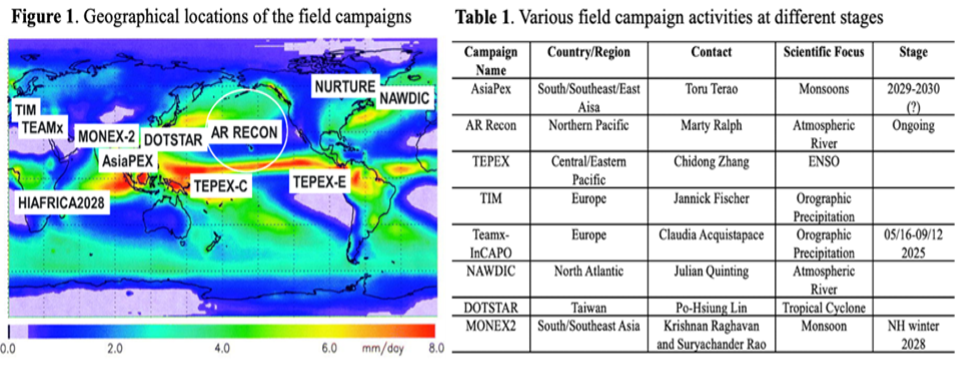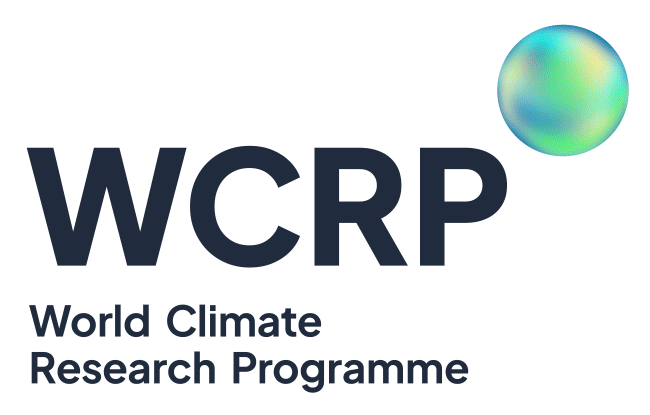To improve precipitation prediction, it is essential to advance data collection, enhance measurement methodologies, deepen process understanding, and engage effectively with relevant stakeholders worldwide. Accordingly, GPEX is planning and implementing the WCRP Years of Precipitation (YoP) as a flagship initiative, leveraging and coordinating with existing WCRP activities and other international projects.
GPEX Working Group 1 (WG1) will engage with national and international funding agencies to identify anchor projects and coordinate global field campaigns centered around these projects. For YoP activities, WG1 will identify key partners and infrastructure to facilitate global field campaigns, conducting at least one month of fieldwork per season in regions where specific precipitation drivers associated with different storm types contribute significantly to mean and extreme precipitation. The scientific focus will encompass a range of precipitation drivers and scales, across diverse regions and seasons.
To be specific, GPEX studies atmospheric rivers (ARs), organized convection (e.g., mesoscale convective systems), monsoons, and tropical cyclones and their precipitation after landfall. These storm types may occur across different seasons and regions. Since specific weather events may or may not occur at a given time, fixed periods are normally used for the campaigns. Additionally, precipitation can result from a combination of phenomena, such as ARs and extratropical cyclones, making it difficult to differentiate the impacts of storm types.
A) Field Campaigns under various stages of development
Several field campaigns are under development (Fig. 1 and Table 1.)

B) First GPEX “Anchor Project” – AR Recon
Identified by GPEX as a major storm type, ARs are transient, elongated corridors of concentrated water vapor transport that can produce precipitation resulting in either beneficial water supply or hazardous flooding. AR Recon supports research and operations to improve understanding and forecasting of extreme precipitation. This program is recognized in the ARROW Act and in the bipartisan AR Forecasting Bill introduced in the U.S. Senate. AR Recon has also been selected as a WWRP “Endorsed Project” and serves as a link between weather and climate. It currently collaborates with global field campaigns like NAWDIC and DOTSTAR as an anchor project for GPEX.
- Typically, 3-4 ARs are present in both the Northern and Southern Hemispheres at any given time.
- ARs primarily occur over oceans, where many standard ground-based observations are unavailable.
- Initial errors in AR position, structure, and strength grow rapidly in forecast cycle, degrading prediction skill.
- These errors amplify quickly due to the crucial role of ARs in determining latent heat release
- AR Recon began over the North Pacific in Jan-Feb and has now expanded to Nov-Mar and the western North Atlantic.
- Global AR Recon Program – 2026 Demonstration (“GARRP-26 Demo”), is planned for Jan and Feb 2026 as an expanded version of AR Recon.
- GARRP-26 Demo includes close coordination with other field campaigns with highly relevant interests:
- SAFARI linking ocean and atmospheric observations (ONR-led)
- NAWDIC in the Northeast Atlantic (European-led)
- NURTURE at high latitudes based in Canada (NASA led)
- TEPEX Tropical Pacific air-sea interaction (NOAA-led)
- AR Recon - University Coordinated Radiosonde Program (CW3E-led)
- The GARRP vision is to improve week-2 forecast skill across the Northern Hemisphere during winter by reducing initial condition errors in the 3-4 ARs typically present.
- Next steps for summer 2025 include integrating AR Recon modeling, physical process studies, and forecast improvement strategies with GPEX’s other working groups, incorporating AR Recon/GARRP data into GPEX communications, exploring southern hemisphere collaborations (including Antarctic field campaigns), and expanding drifting buoy and other global ocean observations.
WG1 - Members
| Name | Function | Affiliation | Country |
| Fred (Marty) Ralph | Co-chair | Pacific Northwest National Laboratory | USA |
| Samson Hagos | Co-chair | Univerity of San Diego | USA |
| Claudia Acquistapace | Member | University of Cologne | Germany |
| Kaustav Chakravarty | Member | Indian Institute of Tropical Meteorology | India |
| Aster Hordofa | Member | Water Institute Technology, Arba Minch University | Ethiopia |
| David Lavers | Member | ECMWF | UK |
| Po Hsiung Lin | Member | Department of Atmospheric Sciences, National Taiwan University | Taiwan (R.O.C.) |
| Paola Verónica Salio | Member | Department of Atmospheric and Ocean Sciences, University of Buenos Aires | Argentina |
| Vijay Tallapragada | Member | NOAA National Weather Service | USA |
| Stefan Terzer-Wassmuth | Member | International Atomic Energy Agency | Austria |
| Satoru Yokoi | Member | Research Institute for Global Change, Japan Agency for Marine-Earth Science and Technology (JAMSTEC) | Japan |

